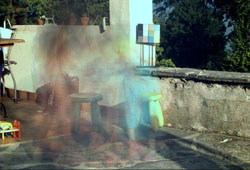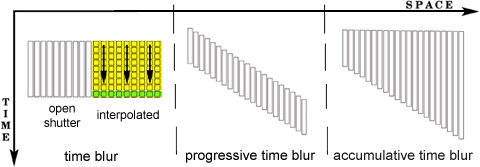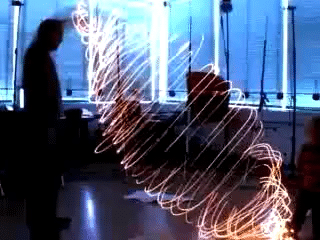FROZEN
MOMENT
LIVE
ACTION
STOP-
START
SLOW
MOTION
TIME
RAMP
SPACE
RAMP
TIME
BLUR
SPACE
BLUR
LONG
EXPOSURE
MULTIPLE
EXPOSURE
OPEN
FLASH
FLASH
TRAIL
LIGHT
PAINTING
MOTION
DISTORTION
MATCH
CUT
UNIVERSAL
CAPTURE
|
TECHNIQUES - TIME BLUR
Time blur is motion blur which results purely from the movement of the subject over time. Time blur usually requires relatively long exposures but it can also be created from multiple frames through interpolation - as in the example to the right.
The shutter speeds of the cameras in Digital Air's systems can be much longer than the frame rate. As a result time blur can be introduced to a shot even at very high frame rates (in cinema cameras higher frame rates necessitate shorter shutter speeds). Additionally, time blur in our systems can be time-progressive, as in the example below.
It's important to note that the virtual point-of-view of our systems can "move" relative to a time-blurred subject without the time blur effecting the background (or any static objects in the scene). This is because Digital Air's systems simulate a virtual moving point of view by cutting across static camera positions - and non-moving objects in static shots are unaffected by time blur (as in the example to the right in which the background is sharp in spite of the interpolated time blur).
By simultaneously opening and then sequentially closing the shutters in our systems we can also record scenes in which the subject is moving and leaving an accumulative trail of time blur (this is similar to the light painting effect only the subject itself becomes the light source). Because this creates a situation where each frame has a different shutter speed an exposure compensation may be made in the aperture settings or with NDs, or the effect can be recorded with a moving subject on a black background.
| |

original time sequence
 interpolated time blur interpolated time blur
|

|
EXAMPLE - TIME BLUR

Project: test - twirling Christmas tree lights
Equipment: 32 camera HD-1 digital system
| |
This example of time blur was recorded with 32 digital cameras running synchronously and out of phase by 1/60th of a second. The cameras were arranged and triggered in a circle such that the triggering cycle revolved constantly around the circle making one complete revolution approximately every half second. Each camera's shutter speed was 1/4 sec. The result is extreme time blur that looks like the cameras were running at only 4 fps while the subject actually moves in slow motion because the frame rate of the final shot is 60 fps.
|
|
|